|
|
|
Sort Order |
|
|
|
Items / Page
|
|
|
|
|
|
|
| Srl | Item |
| 1 |
ID:
167737
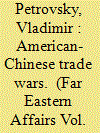

|
|
|
|
|
| Summary/Abstract |
The dispute between the United States and the People's Republic of China over trade and economic issues has a long history. It has now become clear, however, that Donald Trump's protectionist policy is in direct contrast to China's consistent position in defense of free trade, based on the principles of the World Trade Organization (WTO). Washington sees in Beijing its main strategic competitor and has adopted a policy of long-term opposition to China in all spheres, including trade and economics. Having launched a trade war against China, the United States is also doing its best to weaken by noneconomic means their growing competition in the field of high technology.
|
|
|
|
|
|
|
|
|
|
|
|
|
|
|
|
| 2 |
ID:
185848
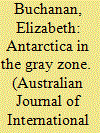

|
|
|
|
|
| Summary/Abstract |
All appears quiet on Australia’s southern front – Antarctica. The continent remains a beacon of cooperation, home to a continued system of international governance and scientific engagement, lauded as a political win from the depths of the Cold War. Beneath the surface, however, this article argues that strategic competition is now building. In Antarctica, this competition takes the form of gray zone activities. This article argues that the proliferation of gray zone challenges could jeopardize the future of the Antarctic Treaty System (ATS). This article analyses gray zone activity in Antarctica and highlights the growing complexity Australia faces, as Canberra pursues the dual objectives of protecting Australia’s territorial claim to the Australian Antarctic Territory (AAT) and bolstering the ATS.
|
|
|
|
|
|
|
|
|
|
|
|
|
|
|
|
| 3 |
ID:
130868
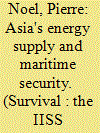

|
|
|
|
|
| Publication |
2014.
|
| Summary/Abstract |
Asia's reliance on international, seaborne energy trade is conducive to strategic cooperation. Whether this will outweigh strategic competition is far from certain. The Asia-Pacific accounts for a large and growing share of the world's energy-demand growth. With imports rising faster than consumption, the region is rapidly becoming the new centre of gravity for global energy markets. Such dynamics have made energy security a key policy concern for Asian states. The naval capacities of these countries are also growing swiftly, prompting some analysts to ask whether an arms race has begun. Although no one would suggest that this build-up of naval power is primarily driven by the need to secure energy supplies, the Chinese and Indian governments have identified energy and resource security as one rationale for developing naval power, particularly blue-water capabilities.
|
|
|
|
|
|
|
|
|
|
|
|
|
|
|
|
| 4 |
ID:
172104


|
|
|
|
|
| Summary/Abstract |
Most debates on U.S. military strategy in the Western Pacific revolve around the question of how to deter China. Advocates of deterrence by punishment believe that the Chinese threat is serious but not critical, because the United States can leverage its global military-technological advantages to preserve a position of regional military primacy. Those in favor of deterrence by denial point to China’s potential and “home advantages,” and argue that the United States should settle for more modest objectives such as preventing Chinese regional military dominance. I argue that the high level of uncertainty around Chinese capabilities and the evolving Sino-American regional military balance have led the United States to adopt a flexible strategy, and embrace distinct–even contradictory–operational concepts to deter Beijing: The United States itself mostly focuses primarily on deterrence by punishment, while actively encouraging and enabling its regional allies to develop deterrence by denial.
|
|
|
|
|
|
|
|
|
|
|
|
|
|
|
|
| 5 |
ID:
134299
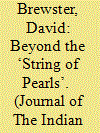

|
|
|
|
|
| Summary/Abstract |
The article will ask whether Sino-Indian strategic competition in the Indian Ocean should be properly understood through the lens of a security dilemma. It examines the strategic positions of India and China in the Indian Ocean and concludes that India has an overwhelming strategic advantage that China cannot realistically mitigate in the foreseeable future. This advantage precludes any real security dilemma arising between them. In fact, both China and India have good reasons to keep strategic competition under control while they each broaden their regional influence.
|
|
|
|
|
|
|
|
|
|
|
|
|
|
|
|
| 6 |
ID:
155245
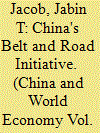

|
|
|
|
|
| Summary/Abstract |
China's Belt and Road Initiative (BRI) is often simplistically understood as being opposed by India and supported by Pakistan. The reality on the ground is rather more complex. The emerging consensus in India appears to be that, far from being exclusively an economic and infrastructure development program, the BRI may be understood as a long-term strategic initiative that seeks to convert China's current economic might into diplomatic influence. While attempts have been made by Beijing, the reflexive Indian suspicion of Chinese international projection, including of China's BRI, has not yet been met by a coherent discourse designed to specifically address Indian concerns. In contrast, in Pakistan, widespread acceptance of the importance and necessity of the China–Pakistan Economic Corridor is increasingly coupled with concerns within sectors of Pakistani society over the fairness, transparency and eventual economic outcomes of the project. Accordingly, this paper is divided into two parts: the first looks at how Indian analysts have viewed and responded to the Chinese discourse and arguments on the BRI; the second considers the debate over the China–Pakistan Economic Corridor within Pakistan.
|
|
|
|
|
|
|
|
|
|
|
|
|
|
|
|
| 7 |
ID:
186280
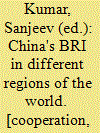

|
|
|
|
|
| Publication |
New Delhi, KW Publishers Pvt Ltd, 2022.
|
| Description |
xxviii, 359p.hbk
|
| Series |
Sapru House Soundings on Area Studies
|
| Standard Number |
9789383445646
|
|
|
|
|
|
|
|
|
|
|
|
Copies: C:1/I:0,R:0,Q:0
Circulation
| Accession# | Call# | Current Location | Status | Policy | Location |
| 060197 | 338.951/KUM 060197 | Main | On Shelf | General | |
|
|
|
|
| 8 |
ID:
179268
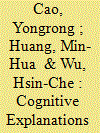

|
|
|
|
|
| Summary/Abstract |
In recent years, the economic development of China and India and their border confrontations have intensified bilateral strategic competition. This study used the State of Democracy in South Asia survey to identify dual mindsets of competition and contingency that drive how Indians perceive China’s influence in Asia. These two mindsets are based on a cognitive schema characterized by a political predisposition against China. However, this negative orientation is moderated as more information is acquired regarding the impact of China on India. The competition mindset does not always manifest itself, and is only cognitively activated when a change is perceived in India’s power status. On the other hand, the contingent principle appears whenever competition seems to have abated, or disadvantage seems unavoidable. The mindsets of competition and contingency are not only relevant to the evolution of Sino–Indian relations, but also explain how Indian policymakers behave and respond in international society.
|
|
|
|
|
|
|
|
|
|
|
|
|
|
|
|
| 9 |
ID:
189486
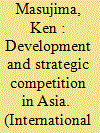

|
|
|
|
|
| Summary/Abstract |
The prioritization of economic development, considered as a key in understanding the co-existence of heightened security situations and growing economic interdependence in Asia, should be considered as a political strategy among many chosen by political elites in their own political context rather than a consensus implying general acquiescence to the idea. The recent competition between the Belt and Road Initiative by China and the Free and Open Indo-Pacific by the United States, Japan, Australia, and India confirms and reinforces the tendency toward the mobilization of development policy for increasingly strategic purposes in the context of rising tension between the United States and China. At the same time, there is some cooperative element in prioritizing development in Asia.
|
|
|
|
|
|
|
|
|
|
|
|
|
|
|
|
| 10 |
ID:
179505
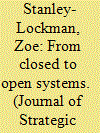

|
|
|
|
|
| Summary/Abstract |
The return to strategic competition affects the US military services differently, but all are contending with the challenge of renewing their military advantage against near-peer, technologically advanced competitors. Commercially driven innovation trends simultaneously challenge the way that the US military manages technology. This article traces the pursuits to institutionalise open innovation practices inside the services to incorporate emerging technologies into their envisaged competitive advantage. Rather than treating the US military as a monolithic entity, this article assesses how new service-level organisations differ in the ways and means they pursue innovation and seeks to explain why those differences persist.
|
|
|
|
|
|
|
|
|
|
|
|
|
|
|
|
| 11 |
ID:
166119
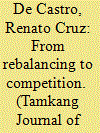

|
|
|
|
|
| Summary/Abstract |
During his two terms as U.S. president, former President Barack Obama made the Asia- Pacific region the focal point of American strategic attention. In November 2011, he announced the U.S. pivot to Asia. His goal was to constrain China from easing out the U.S. as East Asia's strategic offshore balancer. Contrary to expectations, the 2016 election of Donald Trump, did not spell the end of the strategic rebalancing to Asia. For the Trump Administration, the Asia-Pacific remains a top security priority for two reasons. One, North Korea's nuclear weapons program poses a clear and present danger to the U.S. and its allies in Northeast Asia. And two, China's naval expansion, island-building activities, and militarization efforts in the South China Sea threaten not only the freedom of navigation but also the rules-based international order. In conclusion, the article argues that there is a great deal of consistency between the Obama Administration's strategic rebalancing and the Trump Administration's emerging Indo-Pacific Strategy. However, the current administration's Indo-Pacific strategy reflects both continuity as well as discontinuity with its predecessor's rebalancing policy. On the one hand, neither U.S. national security interests nor Asia's importance to Washington has changed in the Trump Administration. On the other hand, its policy also reflects discontinuity as it characterized China as a threat to U.S. interests and is geared to engage this emergent power in a long strategic competition in the Indo-Pacific region.
|
|
|
|
|
|
|
|
|
|
|
|
|
|
|
|
| 12 |
ID:
185317
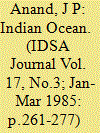

|
|
|
| 13 |
ID:
138232
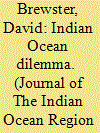

|
|
|
|
|
| Summary/Abstract |
This paper looks at the key strategic issues faced by China in the Indian Ocean within the context of growing Sino-Indian rivalry. It makes two basic arguments: first, that China has considerable strategic disadvantages in the Indian Ocean as compared with India; and second, that India has had more success than China in developing security relationships in the region. These propositions differ from a more common narrative, according to which China is establishing security relationships throughout the region that seriously threaten India. This paper argues that, on the contrary, China faces a strategic dilemma right across the Indian Ocean that it will only be able to partially mitigate in the short to medium term. Perhaps we should be asking how China’s strategic vulnerability should be best managed.
|
|
|
|
|
|
|
|
|
|
|
|
|
|
|
|
| 14 |
ID:
167639
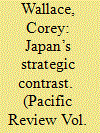

|
|
|
|
|
| Summary/Abstract |
Since 2008 the Japanese government has become more responsive to the exercise of Chinese economic, diplomatic and military power in Southeast Asia, suggesting an intensifying rivalry. The Japanese government has thrown off any reticence about self-promotion by more forcefully positioning Japan as a sensitive and sustainable strategic partner for Southeast Asian nations in a strategic contrast with the People’s Republic of China (PRC). Rather than trying to contain China, Tokyo is seeking to mediate how China turns its material resources into influence. Despite an increasing asymmetry in material resources between China and Japan, this article argues that Japan maintains a surprising ability to influence the preferences of Southeast Asian nations and responses to exercises of PRC power, which in turn has allowed Japan to influence China’s regional strategy.
|
|
|
|
|
|
|
|
|
|
|
|
|
|
|
|
| 15 |
ID:
173189


|
|
|
|
|
| Summary/Abstract |
The 2018 U.S. National Defense Strategy notes that the United States faces “an increasingly complex global security environment, characterized by overt challenges to the free and open international order and the re-emergence of long-term, strategic competition between nations.” In the ensuing months, much has been made of the security-related aspects of this return to great power competition — including Donald Trump’s role in the decline of the existing arms control architecture, responses to Russia’s annexation of Ukraine, and China’s use of subconventional — or “gray zone” — military operations in the South China Sea. What this analysis tends to miss, however, are the economic dimensions of strategic competition. To address the question of how insights from international political economy and security studies can be usefully combined to examine strategic competition, we examine how economic statecraft increasingly takes the form of economic policy beyond sanctions regimes. We argue that economic statecraft has become an increasingly central aspect of geostrategic consideration and consider how economic statecraft is being transformed in the current era.
|
|
|
|
|
|
|
|
|
|
|
|
|
|
|
|
| 16 |
ID:
170415
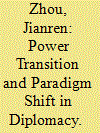

|
|
|
|
|
| Summary/Abstract |
The rise of China is one of the most notable events in the early 21st century. The strategic impacts of its rise and interactions between the hegemonic power and the rising power have become focal points for scholars in the field of international relations. This article uses prospect theory, power transition theory, and nuclear deterrence theory as the basis for constructing a theory of strategic competition to explain the relationship between the hegemonic power and the rising power, and the strategic interactions between them during the power transition process. This new theory of strategic competition maintains that states take diplomatic actions not just to seek gains, but also to avoid losses. Building upon a critical review and revision of power transition theory, the theory of strategic competition proposes that before the rising power overtakes it, the hegemonic power will take action to avoid incurring losses, and that in response the rising power will passively take action to avoid its own losses. After the rising power has overtaken the hegemonic power, however, it will take action to expand its interests, and the hegemonic power will then passively take action to avoid its own losses. Under the inhibitive influence of nuclear deterrence, strategic competition between the hegemonic power and the rising power is limited to peaceful measures including diplomatic means. This article tests the theory of strategic competition through examining the paradigm shifts in diplomacy of the US and China that have occurred since 2010.
|
|
|
|
|
|
|
|
|
|
|
|
|
|
|
|
| 17 |
ID:
179504
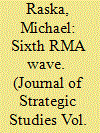

|
|
|
|
|
| Summary/Abstract |
The Revolution in Military Affairs, its concepts, processes, and debates, have evolved in five ‘IT-RMA waves’ since the 1980s. None of them, however, have fully achieved their intended outcomes as their ambitious premises have exceeded available technologies, budgetary resources, and operational capabilities of a given era. This paper argues that a new ‘artificial intelligence-driven RMA’ wave differs in the political, strategic, technological, and operational diffusion paths and patterns. While the AI-RMA may affect select countries and regions disproportionately, its technological advances coupled with an ongoing strategic competition is sufficiently broad to stipulate significant military changes across geopolitical lines.
|
|
|
|
|
|
|
|
|
|
|
|
|
|
|
|
| 18 |
ID:
183367
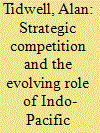

|
|
|
|
|
| Summary/Abstract |
Scholarship on paradiplomacy, or sub-national diplomacy, has often focused on economics, trade, cooperation and politics. The deepening of strategic competition between the People’s Republic of China and the United States has raised the stakes for sub-national diplomacy. While US-PRC strategic competition occurs primarily at the national level, the subnational level plays an important role in terms of creating opportunities for influence and advancing the strategic interests. In this article recent paradiplomacy in the Indo-Pacific is examined, as is the is the intersection of paradiplomacy with strategic competition.
|
|
|
|
|
|
|
|
|
|
|
|
|
|
|
|
| 19 |
ID:
177293
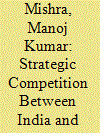

|
|
|
|
|
| Summary/Abstract |
The continuing border clashes and military face-off between the Indian Army and the Chinese People’s Liberation Army (PLA) can no more be viewed merely as the Chinese attempts at redrawing the border between the two rather it is integral to China’s larger claims over the Himalayan landscape.
|
|
|
|
|
|
|
|
|
|
|
|
|
|
|
|
| 20 |
ID:
120519
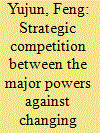

|
|
|
|
|
|
|
|